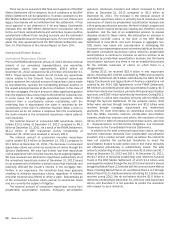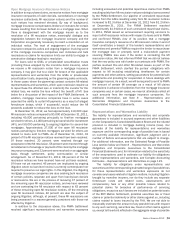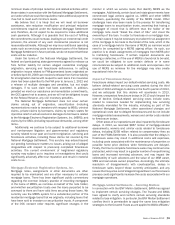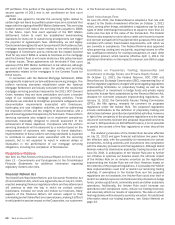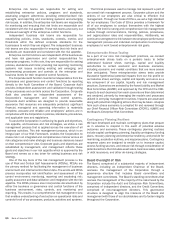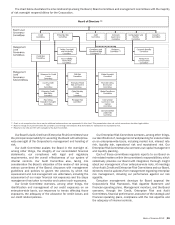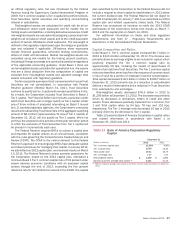Bank of America 2012 Annual Report Download - page 64
Download and view the complete annual report
Please find page 64 of the 2012 Bank of America annual report below. You can navigate through the pages in the report by either clicking on the pages listed below, or by using the keyword search tool below to find specific information within the annual report.62 Bank of America 2012
the final rule and what the ultimate impact of the final rule will be
on our CRES, Global Markets and other business segments or on
our results of operations.
The Consumer Financial Protection Bureau
The Financial Reform Act established the Consumer Financial
Protection Bureau (CFPB), which principally regulates the offering
of consumer financial products or services under federal consumer
financial laws, and which has commenced its supervisory
oversight. Certain federal consumer financial laws to which the
Corporation is subject including, but not limited to, the Equal Credit
Opportunity Act, Home Mortgage Disclosure Act, Electronic Fund
Transfers Act, Fair Credit Reporting Act, Truth in Lending and Truth
in Savings Acts are enforced by the CFPB, subject to certain
statutory limitations. Through its rulemaking authority, the CFPB
has promulgated several proposed and final rules that will affect
our consumer businesses. Among these initiatives is a recently-
issued final rule implementing sections of the Financial Reform
Act establishing “ability to repay” and “qualified mortgage”
standards under the Truth in Lending Act. In addition, the CFPB
issued a final rule establishing mortgage loan servicing standards
through amendments to the Real Estate Settlement Procedures
Act. The CFPB has also proposed rules addressing items such as
remittance transfer services, appraisal requirements and loan
originator compensation requirements. The Corporation is
evaluating the various CFPB rules and proposals and devoting
substantial compliance, legal and operational business resources
to facilitate compliance with these rules by their respective
effective dates. In addition, the Corporation has cooperated with
the CFPB on several industry-related information collection
requests involving consumer financial products and services,
including overdraft fees and practices.
Certain Other Provisions
The Financial Reform Act also expands the role of state regulators
in enforcing consumer protection requirements over banks and
disqualifies trust preferred securities and other hybrid capital
securities from Tier 1 capital. Many of the provisions under the
Financial Reform Act have only begun to be implemented or remain
to be implemented in the future and will be subject both to further
rulemaking and the discretion of applicable regulatory bodies. For
additional information regarding regulatory capital and other rules
proposed by federal regulators, see Capital Management –
Regulatory Capital Changes on page 68.
The Financial Reform Act will continue to have an adverse
impact on our earnings through fee reductions, higher costs and
imposition of new restrictions on us. The Financial Reform Act may
also continue to have a material adverse impact on the value of
certain assets and liabilities held on our balance sheet. The
ultimate impact of the Financial Reform Act on our businesses will
depend on regulatory interpretation and rulemaking, as well as the
success of any of our actions to mitigate the negative impact of
certain provisions.
Transactions with Affiliates
The terms of certain of our OTC derivative contracts and other
trading agreements of the Corporation provide that upon the
occurrence of certain specified events, such as a change in our
credit ratings, Merrill Lynch and other non-bank affiliates may be
required to provide additional collateral or to provide other
remedies, or our counterparties may have the right to terminate
or otherwise diminish our rights under these contracts or
agreements. In the event of further downgrades of the credit
ratings of the Corporation and other non-bank affiliates, we may
engage in discussions with certain derivative and other
counterparties regarding their rights under these agreements,
including potentially naming new counterparties. Our ability to
substitute or make changes to these agreements to meet
counterparties’ requests may be subject to certain limitations,
including counterparty willingness, regulatory limitations on
naming BANA as the new counterparty, and the type or amount of
collateral required. It is possible that such limitations on our ability
to substitute or make changes to these agreements, including
naming BANA as the new counterparty, could adversely affect our
results of operations.
Other Matters
The Corporation has established guidelines and policies for
managing capital across its subsidiaries. The guidance for the
Corporation’s subsidiaries with regulatory capital requirements,
including branch operations of banking subsidiaries, requires each
entity to maintain satisfactory capital levels. This includes setting
internal capital targets for the U.S. bank subsidiaries to exceed
“well-capitalized” levels. The U.K. has adopted increased capital
and liquidity requirements for local financial institutions, including
regulated U.K. subsidiaries of non-U.K. BHCs and other financial
institutions as well as branches of non-U.K. banks located in the
U.K. In addition, the U.K. has proposed the creation and production
of recovery and resolution plans, commonly referred to as living
wills, by significant regulated legal entities.
Managing Risk
Overview
Risk is inherent in every material business activity that we
undertake. Our business exposes us to strategic, credit, market,
liquidity, compliance, operational and reputational risks. We must
manage these risks to maximize our long-term results by ensuring
the integrity of our assets and the quality of our earnings.
Strategic risk is the risk that results from adverse business
decisions, ineffective or inappropriate business plans, or failure
to respond to changes in the competitive environment, business
cycles, customer preferences, product obsolescence, regulatory
environment, business strategy execution, and/or other inherent
risks of the business including reputational risk. Credit risk is the
risk of loss arising from a borrower’s or counterparty’s inability to
meet its obligations. Market risk is the risk that values of assets
and liabilities or revenues will be adversely affected by changes
in market conditions such as interest rate movements. Liquidity
risk is the inability to meet contractual and contingent financial
obligations, on- or off-balance sheet, as they come due.
Compliance risk is the risk that arises from the failure to adhere
to laws, rules, regulations, or internal policies and procedures.
Operational risk is the risk of loss resulting from inadequate or
failed internal processes, people and systems, or external events.
Reputational risk is the potential that negative publicity regarding
an organization’s conduct or business practices will adversely
affect its profitability, operations or customer base, or result in
costly litigation or require other measures. Reputational risk is
evaluated along with all of the risk categories and throughout the
risk management process, and as such is not discussed
separately herein. The following sections, Strategic Risk


